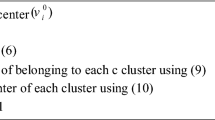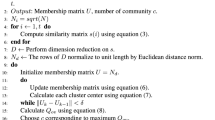Abstract
With the increasing popularity of location-based social networks (LBSNs), community detection has emerged as an important and practical issue. One of the main shortcomings of the previous methods is that cluster’s centers have been selected randomly in clustering the communities; therefore, different results are obtained in each execution. This paper proposes an intelligent method to detect overlapping communities in LBSNs with respect to user check-ins and the attributes of venues and users. In the proposed approach, clustering is performed on the two-segment user-venue edges. The advantage of this approach is the use of subtractive clustering method, which determines cluster centers with a probability, based on the potential of each data point. Furthermore, the specified fuzzy rules have a significant role in determining the appropriate number of cluster centers. The paper concentrates on the data obtained from the Foursquare LBSN. The empirical results of the proposed approach are compared with the previous approach to clustering edges in multi-attribute and multi-mode (M2-clustering) algorithm, and a significant improvement is observed in the cost function of the community detection.




Similar content being viewed by others
References
Ahn YY, Bagrow JP, Lehmann S (2010) Link communities reveal multiscale complexity in networks. Nature 466(7307):761–764
Bao J, Zheng Y, Wilkie D, Mokbel M (2015) Recommendations in location-based social networks: a survey. GeoInformatica 19(3):525–565
Bilenko M, Mooney RJ (2003) Adaptive duplicate detection using learnable string similarity measures. In: Paper presented at the proceedings of the ninth ACM SIGKDD international conference on Knowledge discovery and data mining
Blondel VD, Guillaume JL, Lambiotte R, Lefebvre E (2008) Fast unfolding of communities in large networks. J Stat Mech Theory Exp 2008(10):10008–10020
Bourgain J, Dirksen S, Nelson J (2015) Toward a unified theory of sparse dimensionality reduction in euclidean space. Geom Funct Anal 25(4):1009–1088
Cheng Z, Caverlee J, Lee K, Sui DZ (2011). Exploring millions of footprints in location sharing services. In: Paper presented at the 5th international AAAI conference on weblogs and social media (ICWSM), Catalonia
Chiu S (1994) Fuzzy model identification based on cluster estimation. J Intell Fuzzy Syst 2(3):267–278
Clauset A, Newman ME, Moore C (2004) Finding community structure in very large networks. Phys Rev E 70(6):111–116
Cruz JD, Bothorel C, Poulet F (2011). Entropy based community detection in augmented social networks. In: Paper presented at the 3th international conference on computational aspects of social networks (CASoN), Salamanca
El-Tarabily M, Abdel-Kader R, Marie M, Abdel-Azeem G (2013) A PSO-based subtractive data clustering algorithm. Int J Res Comput Sci 3(2):1
Fortunato S (2010) Community detection in graphs. Phys Rep 486(3–5):75–174
Foursquare (2016). Retrieved from https://foursquare.com/about
Ghazarian S, Nematbakhsh MA (2015) Enhancing memory-based collaborative filtering for group recommender systems. Exp Syst Appl 42(7):3801–3812
Han J, Kamber M, Pei J (2011) Data mining: concepts and techniques. Elsevier, Champaign
Kumar B, Bala PK, Srivastava A (2016) Cosine based latent factor model for precision oriented recommendation. Int J Adv Comput Sci Appl 7(1):451–457
Li N, Chen G (2009) Analysis of a location-based social network. In: Paper presented at the IEEE 4th international conference on computational science and engineering, Vancouver
Newman ME, Girvan M (2004) Finding and evaluating community structure in networks. Phys Rev E 69(2):113–127
Noulas A, Scellato S, Mascolo C, Pontil M (2011) An empirical study of geographic user activity patterns in Foursquare. In: Paper presented at the 5th international conference on weblogs and social media (ICWSM), Catalonia
Pirasteh P, Jung JJ, Hwang D (2014) Item-based collaborative filtering with attribute correlation: a case study on movie recommendation. In: Paper presented at the Asian conference on intelligent information and database systems
Sachan A, Richhariya V (2013) Reduction of data sparsity in collaborative filtering based on fuzzy inference rules. Int J Adv Comput Res 3(2):101
Scellato S, Mascolo C, Musolesi M, Latora V (2010) Distance matters: geo-social metrics for online social networks. In: Paper presented at the 3th international workshop on online social networks (WOSN), Boston
Scellato S, Noulas A, Lambiotte R, Mascolo C (2011) Socio-spatial properties of online location-based social networks. In: Paper presented at the 5th international conference on weblogs and social media (ICWSM), Catalonia
Scott J (2012) Social network analysis. Sage, Los Angeles
Sidorov G, Gelbukh A, Gómez-Adorno H, Pinto D (2014) Soft similarity and soft cosine measure: similarity of features in vector space model. Computación y Sistemas 18(3):491–504
Tantipathananandh C, Berger-Wolf TY (2011) Finding communities in dynamic social networks. In: Paper presented at the IEEE 11th international conference on data mining (ICDM), Vancouver
Vahdat-Nejad H, Zamanifar K, Nematbakhsh N (2013) A new community-based context distribution approach for large-scale pervasive systems. Int J Ad Hoc Ubiquitous Comput 14(2):90–98
Vasconcelos MA, Ricci S, Almeida J, Benevenuto F, Almeida V (2012) Tips, dones and todos: uncovering user profiles in foursquare. In: Paper presented at the 5th ACM international conference on Web search and data mining, Seattle
Wakita K, Tsurumi T (2007) Finding community structure in mega-scale social networks. In: Paper presented at the 16th international conference on World Wide Web, Banff
Wang X, Tang L, Gao H, Liu H (2010) Discovering overlapping groups in social media. In: Paper presented at the IEEE 10th international conference on data mining (ICDM), Sydney
Wang Z, Zhou X, Zhang D, Guo B, Yu Z (2013) Community detection and profiling in location-based social networks creating personal, social, and urban awareness through pervasive computing. IGA Global, Hershey, pp 158–175
Wang Z, Zhang D, Zhou X, Yang D, Yu Z, Yu Z (2014) Discovering and profiling overlapping communities in location-based social networks. IEEE Trans Syst Man Cybern Syst 44(4):499–509
Yager R, Filev D (1994) Generation of fuzzy rules by mountain clustering. J Intell Fuzzy Syst 2(3):209–219
Yang D, Zhang D, Zheng VW, Yu Z (2015) Modeling user activity preference by leveraging user spatial temporal characteristics in LBSNs. IEEE Trans Syst Man Cybern Syst 45(1):129–142
Ye M, Janowicz K, Mülligann C, Lee W-C (2011) What you are is when you are: the temporal dimension of feature types in location-based social networks. In: Paper presented at the 19th ACM SIGSPATIAL international conference on advances in geographic information systems
Zheng Y (2011) Location-based social networks: users computing with spatial trajectories. Springer, New York, pp 243–276
Zheng Y, Xie X (2011) Location-based social networks: locations. Computing with spatial trajectories. Springer, New York, pp 277–308
Zhou J, Luo T (2010) A novel approach to solve the sparsity problem in collaborative filtering. In: Paper presented at the 2010 international conference on networking, sensing and control (ICNSC)
Zhou Y, Cheng H, Yu JX (2009) Graph clustering based on structural/attribute similarities. VLDB Endow 2(1):718–729
Author information
Authors and Affiliations
Corresponding author
Rights and permissions
About this article
Cite this article
Ghane’i-Ostad, M., Vahdat-Nejad, H. & Abdolrazzagh-Nezhad, M. Detecting overlapping communities in LBSNs by fuzzy subtractive clustering. Soc. Netw. Anal. Min. 8, 23 (2018). https://doi.org/10.1007/s13278-018-0502-5
Received:
Revised:
Accepted:
Published:
DOI: https://doi.org/10.1007/s13278-018-0502-5




